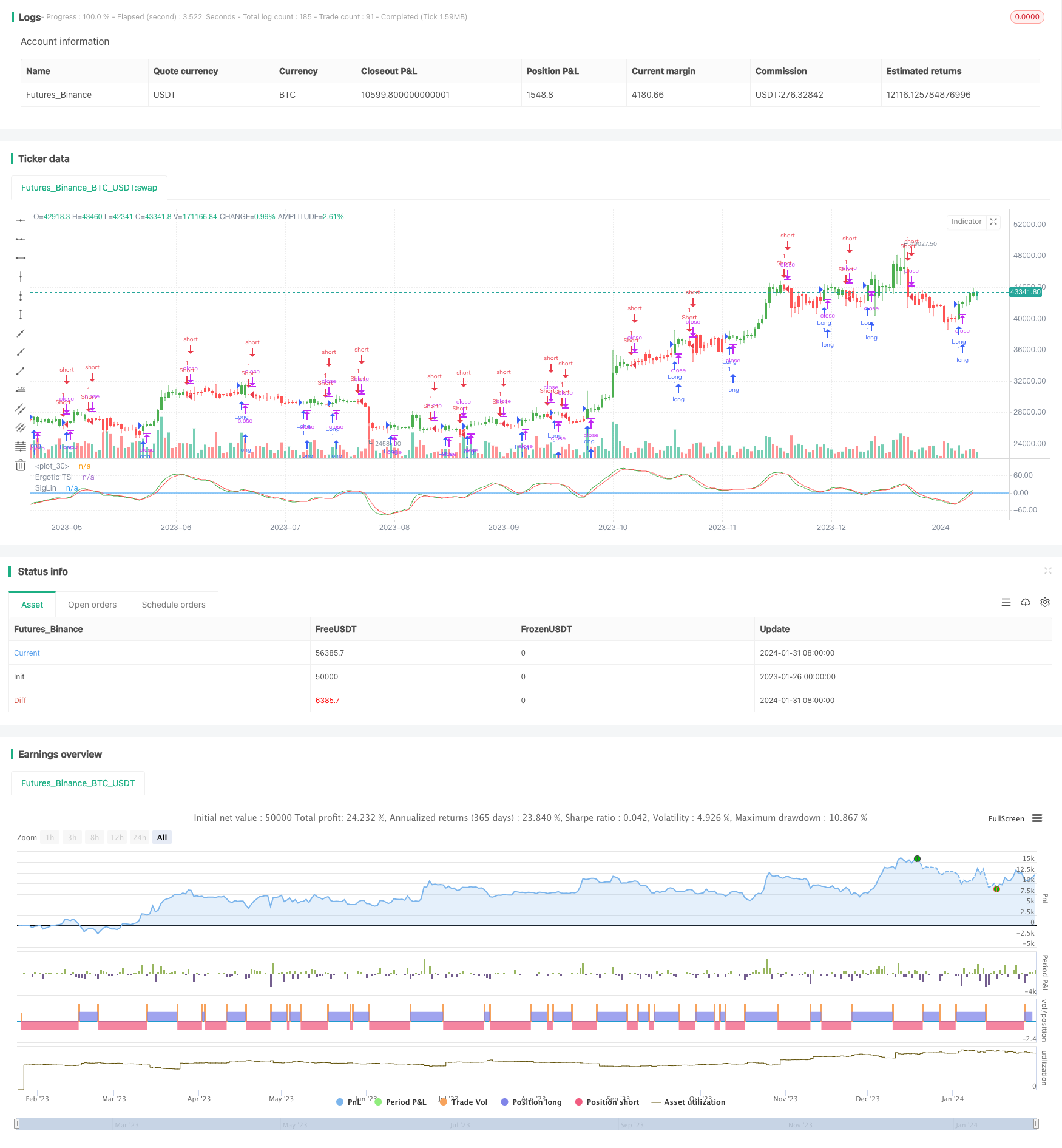Estrategia de negociación de convergencia de la dirección del impulso ergótico
El autor:¿ Qué pasa?, Fecha: 2024-02-02 10:51:11Las etiquetas:

Resumen general
El nombre de esta estrategia es Ergotic Momentum Direction Convergence Trading Strategy. Es una estrategia de negociación cuantitativa diseñada sobre la base del indicador técnico descrito en el libro de William Blau
Estrategia lógica
El indicador central de esta estrategia es la ETI "Ergotica", cuya fórmula de cálculo es la siguiente:
Val1 = 100 * EMA(EMA(EMA(price change, r), s), u)
Val2 = EMA(EMA(EMA(absolute value of price change, r), s), u))
Ergotic TSI = If Val2 != 0, Val1/Val2, else 0
donde r, s, u son parámetros de suavizado. Este indicador refleja la relación entre el cambio de precio y el valor absoluto del cambio de precio, que pertenece al indicador del oscilador de impulso. Luego calcula la media móvil EMA de la TSI ergótica como la línea de señal. Ir largo cuando la TSI cruza la línea de señal y ir corto cuando cruza por debajo.
Análisis de ventajas
Las principales ventajas de esta estrategia son las siguientes:
- Capacidad de captar las tendencias de cambio de precios
- Buen filtrado de las fluctuaciones de precios
- Características de divergencia relativamente buenas
- Configuración de parámetros flexibles para ajustar el suavizado
Análisis de riesgos
Esta estrategia también presenta algunos riesgos:
- Pueden producirse señales erróneas en los puntos de inversión de tendencia
- Los parámetros no adecuados pueden perder oportunidades comerciales o aumentar las señales falsas.
- Los parámetros deben ajustarse adecuadamente a los diferentes productos y entornos comerciales Los riesgos pueden controlarse optimizando los parámetros, combinando otros indicadores para confirmarlos y estableciendo el stop loss.
Direcciones de optimización
Esta estrategia puede optimizarse en los siguientes aspectos:
- Prueba diferentes entradas de precios, como el precio de apertura, cierre, precio medio, etc.
- Ajuste r, s, u valores de parámetros para encontrar combinaciones óptimas de parámetros
- Añadir otros indicadores o filtros para confirmar más las señales
- Establecer puntos de stop loss y mecanismos de salida
Conclusión
Esta estrategia integra consideraciones de cambio de impulso, juicio de tendencia y características de divergencia. Puede capturar eficazmente las oportunidades de tendencia. Con la optimización de parámetros, filtración de señales y métodos de control de riesgos, se puede lograr un buen rendimiento de la estrategia. En general, la estrategia está diseñada razonablemente y vale la pena una mayor investigación y práctica.
/*backtest
start: 2023-01-26 00:00:00
end: 2024-02-01 00:00:00
period: 1d
basePeriod: 1h
exchanges: [{"eid":"Futures_Binance","currency":"BTC_USDT"}]
*/
//@version = 2
////////////////////////////////////////////////////////////
// Copyright by HPotter v1.0 13/12/2016
// r - Length of first EMA smoothing of 1 day momentum 4
// s - Length of second EMA smoothing of 1 day smoothing 8
// u- Length of third EMA smoothing of 1 day momentum 6
// Length of EMA signal line 3
// Source of Ergotic TSI Close
//
// This is one of the techniques described by William Blau in his book "Momentum,
// Direction and Divergence" (1995). If you like to learn more, we advise you to
// read this book. His book focuses on three key aspects of trading: momentum,
// direction and divergence. Blau, who was an electrical engineer before becoming
// a trader, thoroughly examines the relationship between price and momentum in
// step-by-step examples. From this grounding, he then looks at the deficiencies
// in other oscillators and introduces some innovative techniques, including a
// fresh twist on Stochastics. On directional issues, he analyzes the intricacies
// of ADX and offers a unique approach to help define trending and non-trending periods.
//
// You can use in the xPrice any series: Open, High, Low, Close, HL2, HLC3, OHLC4 and ect...
// You can change long to short in the Input Settings
// Please, use it only for learning or paper trading. Do not for real trading.
////////////////////////////////////////////////////////////
strategy(title="Ergotic TSI Strategy Backtest")
r = input(4, minval=1)
s = input(8, minval=1)
u = input(6, minval=1)
SmthLen = input(3, minval=1)
reverse = input(false, title="Trade reverse")
hline(0, color=blue, linestyle=line)
xPrice = close
xPrice1 = xPrice - xPrice[1]
xPrice2 = abs(xPrice - xPrice[1])
xSMA_R = ema(ema(ema(xPrice1,r), s),u)
xSMA_aR = ema(ema(ema(xPrice2, r), s),u)
Val1 = 100 * xSMA_R
Val2 = xSMA_aR
xTSI = iff (Val2 != 0, Val1 / Val2, 0)
xEMA_TSI = ema(xTSI, SmthLen)
pos = iff(xTSI > xEMA_TSI, 1,
iff(xTSI < xEMA_TSI, -1, nz(pos[1], 0)))
possig = iff(reverse and pos == 1, -1,
iff(reverse and pos == -1, 1, pos))
if (possig == 1)
strategy.entry("Long", strategy.long)
if (possig == -1)
strategy.entry("Short", strategy.short)
barcolor(possig == -1 ? red: possig == 1 ? green : blue )
plot(xTSI, color=green, title="Ergotic TSI")
plot(xEMA_TSI, color=red, title="SigLin")
- Estrategia dinámica de cruce entre SMMA y SMA
- Estrategia de seguimiento de tendencias basada en bandas de Bollinger, RSI y media móvil
- Estrategia de negociación de tendencias basada en el indicador MACD
- Estrategia de media estocástica y móvil con filtros dobles
- Estrategia de tendencia basada en el índice de rentabilidad de las acciones
- Estrategia de ruptura de la media móvil de un solo punto
- Estrategia de cruce de la media móvil
- Estrategia de la SuperTendencia
- Parabolic Period y Bollinger Band Combinado Moving Stop Loss Strategy
- Estrategia de negociación basada en el precio promedio móvil
- Estrategia de negociación de media móvil y estocástica
- Optimización de la tendencia de la media móvil doble siguiendo una estrategia basada en la combinación de indicadores
- La estrategia de comercio cuantitativo eficiente que combina
- Estrategia combinada de doble cruce de media móvil e indicador Williams
- La estrategia de la línea de plata de impulso
- Estrategia contraria a la volatilidad de la RWI
- Estrategia para el seguimiento de la tendencia SAR parabólica para la inversión de pérdidas
- Estrategia de intercambio de indicadores de impulso
- Estrategia de interrupción de la oscilación eficiente con doble stop-profit y stop-loss
- Estrategia de ruptura de doble canal